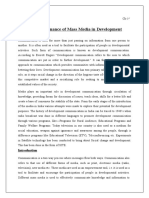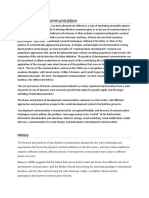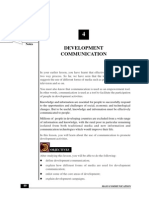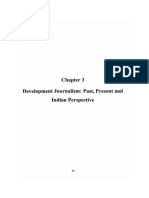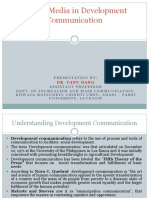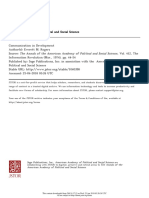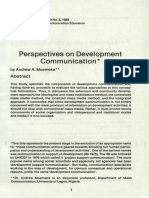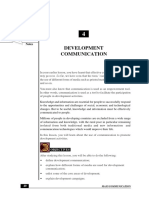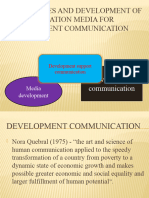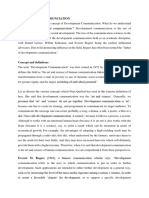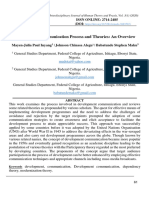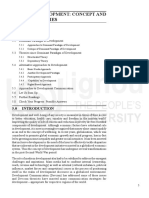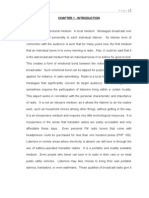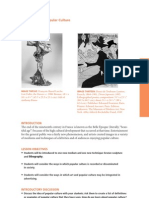© 2020 IJRAR March 2020, Volume 7, Issue 1 www.ijrar.
org (E-ISSN 2348-1269, P- ISSN 2349-5138)
DEVELOPMENT OF COMMUNICATION IN INDIA
: PROSPECT AND TRENDS
Deepak Kumar
Research Scholar
Department of Sociology
T.M. Bhagalpur University, Bhagalpur
ABSTRACT
How did the discipline and practice of development communication begin? Who were the founders and how were the
first experiments implemented? The purpose of this paper is to provide an overview of development communication. To
do so, the first section focuses on the theoretical perspective and evolution of development communication. This study
then specifies the components of development communication and, having done so, proceeds to evaluate the various
approaches to this conceptual formulation. Thus, it discusses the extension and community development approach, the
ideological and mass mobilization method, the centralized mass media method, the localized mass media method, and
the integrated approach. It concludes that since development communication is not simply concerned with the mere
provision of information on development activities, it should not stop with conventional mass media. Rather, it must
involve strong components of social organization and interpersonal and traditional modes and media if it is to
succeed.
Keywords: Development communication, Community development, Mass media methods, Social organizations,
Changing technologies etc.
Introduction
Development and communication are two terms heavily loaded with different conceptions and a richness of
uses and functions shaped by their various theoretical underpinnings. Such richness often leads to ambiguities and a
lack of clarity that affects the field of development communication. The wide range of interpretations of key
terminology and the rapid evolution of some concepts have led to inconsistencies in the way basic terms are
understood and used. What we have here, in fact, is more of an approach than a discipline. As far as its definitions are
concerned, they usually consist of general statements. Thus, the communication media, in the context of development,
are generally used to support development initiatives by the dissemination of messages that encourage the public to
support development oriented projects. Although development strategies in developing countries diverge widely, the
usual pattern for broadcasting and the press has been predominantly the same: informing the population about projects,
illustrating the advantages of these projects, and recommending that they be supported. A typical example of such a
strategy is situated in the area of family planning, where communication means such as posters, pamphlets, radio, and
television attempt to persuade the public to accept birth control methods. Similar strategies are used in campaigns
regarding health and nutrition, agricultural projects, education, and so on.
IJRAR2001810 International Journal of Research and Analytical Reviews (IJRAR) www.ijrar.org 715
�© 2020 IJRAR March 2020, Volume 7, Issue 1 www.ijrar.org (E-ISSN 2348-1269, P- ISSN 2349-5138)
The concept of development communication arose within the framework of the contribution that
communication and the media made to development in the countries of the Third World. Development
communications are organized efforts to use communications processes and media to bring social and economic
improvements, generally in developing countries. The field emerged in the late 1950's amid high hopes that radio and
television could be put to use in the world's most disadvantaged countries to bring about dramatic progress. Early
communications theorists like Wilbur Schramm and Daniel Lerner based their high expectations upon the apparent
success of World War II propaganda, to which academia and Hollywood had contributed. Also with World War II
came dozens of new, very poor, countries, left by their former colonial overseers with little infrastructure, education, or
political stability. It was widely accepted that mass media could bring education, essential skills, social unity, and a
desire to "modernize." Walt Rostow theorized that societies progress through specific stages of development on their
way to modernity, what he termed "the age of high mass consumption." Lerner suggested that exposure to Western
media would create "empathy" for modern culture, and a desire to move from traditional to modern ways. Early
development communications, especially that sponsored by the U.S. government, was also seen as a means of
"winning hearts and minds" over to a capitalist way of life.
Projects embodying these philosophies have enjoyed little success. In the 1970s and 1980s, a new paradigm of
development communication emerged which better recognized the process of deliberate underdevelopment as a
function of colonialism, the great diversity of the cultures involved, the differences between elite versus popular goals
for social change, the considerable political and ideological constraints to change, and the endless varieties of ways
different cultures communicate. But in some instances mass media technologies, including television, have been
"magic multipliers" of development benefits. Educational television has been used effectively to supplement the work
of teachers in classrooms in the teaching of literacy and other skills, but only in well designed programs which are
integrated with other educational efforts. Consumer video equipment and VCRs have been used to supplement
communications efforts in some small projects. Some developing countries have demonstrated success in using
satellite television to provide useful information to portions of their populations out of reach of terrestrial broadcasting.
In 1975 and 1976, an experimental satellite communications project called SITE (Satellite Instructional Television
Experiment) was used to bring informational television programs to rural India. Some changes in beliefs and behaviors
did occur, but there is little indication that satellite television was the best means to that end. The project did lead to
Indian development of its own satellite network. China has also embarked on a ambitious program of satellite use for
development, claiming substantial success in rural education. When television has succeeded as an educational tool in
developing countries, it is only when very specific viewing conditions are met. For example, programs are best viewed
in small groups with a teacher to introduce them and to lead a discussion afterwards.
In this new view of development, communication becomes an important catalyst for change, but not its cause.
Local folk media, for example, is employed to reduces media's bias toward literacy and provide information in a
traditional, familiar form. Development journalism provides people with information on change in their society, and
works at the local level to advocate change. Where mass media is now employed in developing societies, community
newspapers and radio prove far more accessible and useful than television. The rapid spread of entertainment
television in the developing world is proving to be more a disruption to traditional social structures than an agent of
progress. One emerging genre of television does show promise for contributing to development. The telenovela,
pioneered in Brazil, has demonstrated some success in disseminating “prosocial” messages. Such programs are now
IJRAR2001810 International Journal of Research and Analytical Reviews (IJRAR) www.ijrar.org 716
�© 2020 IJRAR March 2020, Volume 7, Issue 1 www.ijrar.org (E-ISSN 2348-1269, P- ISSN 2349-5138)
being evaluated in many countries for their effectiveness in contributing to population control, health education, and
other development goals.
Development Communication in India Tracing its history we have to go back to communities who listened to
rural radio broadcasts in the 1940s, the Indian school of development communication. One distinguishing element of
those early programs was that they focused on the use of indigenous languages –Marathi, Gujarati and Kannada.
India's earliest organized experiments in development communication were held in the 1960s, sponsored by India's
universities and other educational institutions, and by the Bretton Woods school institutions. Educational institutions
that played an important part in this effort include the University of Poona, the Centre for the Study of Developing
Societies, Delhi University, the Christian Institute for the Study of Religion and Society and the University of Kerala.
India is a developing country with lot of achievements in all the fields of modern day life including that of science &
technology, agriculture and industry. Now development communication is such a tool of development that it is highly
necessary for a developing nation like us. It has therefore been increasingly recognized that people's active
participation is an essential component of sustainable development. Any intervention with the intent of achieving a real
and sustainable improvement in the living conditions of people is doomed to failure unless the intended beneficiaries
are actively involved in the process. Unless people participate in all phases of an intervention, from problem
identification to research and implementation of solutions, the likelihood that sustainable change will occur is slim.
Development communication is at the very heart of this challenge: it is the process by which people become leading
actors in their own development. Communication enables people to go from being recipients of external development
interventions to generators of their own development. The 20th century has witnessed the immense impact of
communication technologies, from the spread of sound recording, motion pictures and radio as worldwide phenomena
to the emergence of television as a dominant influence in nearly every institution, to the explosion of the Internet at the
turn of the new century. The digital revolution is far from over, as new inventions repeatedly challenge assumptions
that were themselves formed only yesterday. This is an exciting and critically important moment for communication
scholars to contribute to understanding, and shaping the parameters of our changing technological and academic
environment.
Relevance of Development Communication in India
Development communication is an essential feature for the Indian situation as we are still a developing nation
with a large population next only to that of China. It is important to note that we do possess an enormously large
amount of resources of all kinds including human and natural ones. But we are yet to achieve the kind of universal
development of masses which should have been the optimum given the country‘s situation. Immediately after
Independence in 1947, we faced the challenge of bringing about an equitable and regionallybalanced distribution of
wealth and development of the distant places of the country with limited resources. But, while the efforts of the
government authorities are growing high, the population is also growing at an explosive rate over the years, thus
causing a negative effect on all developmental initiatives.
It is important to note that India also possesses the largest pool of trained manpower in science and technology
though our living standard still deserves a lot to be done. This is why development communication is still highly
relevant for the Indian situation and its significance is growing every passing year due to the changing scenario. It is
common knowledge that the more than two centuries of colonial rule of the country had left us with a very low level of
progress along with an extremely higher rate of exploitation which is normal under such circumstances. This has left
IJRAR2001810 International Journal of Research and Analytical Reviews (IJRAR) www.ijrar.org 717
�© 2020 IJRAR March 2020, Volume 7, Issue 1 www.ijrar.org (E-ISSN 2348-1269, P- ISSN 2349-5138)
the state machinery of the country after Independence with several major and vital challenges. These included – a very
low level of literacy, lack of an adequate industrial base and infrastructure etc. among others. Our experience of the
past fifty one years has demonstrated the crucial importance of communication in the field of development. Within this
perspective of development communication, two trends developed successively: an approach that favored largescale
actions and relied on the mass media, and an approach that promoted grassroots communication (also called
community communication), promoting smallscale projects and relying especially on the light media (videos, posters,
slide presentation, etc.). These trends, which still coexist today to various degrees within the field of development
communication, are linked to the evolution of the development and communication models that have marked
development efforts up to now.
The trend toward mass communication initially marked the first two decades during which the media were
utilized in the field of development. It espoused the idea that it was enough to disseminate the knowledge and the
technologies of the North to ensure that they were adopted. Once adopted, they would achieve the development of the
South. This first vision of development is referred to as the paradigm of "modernization." These initial experiences,
centered mainly around the mass media, relied both on a communication model based on persuasion and information
transmission, and on a development model based on increasing economic activity and changes in values and attitudes.
Conceptual Evolution From the 1940‘s to the 60‘s, the age of the big media, the various communications
approach to development included understanding in three areas (i) communication effects approach (ii) Diffusion of
innovations approach and (iii) Mass Media and the modernization approach. In the communications effects approach,
the earliest models of mass media effects conceptualized the impact of mass media as direct, powerful and uniform on
individuals living in modern, industrial societies termed as mass societies. Also, the earlier models saw communication
as a linear and one way process flowing from a powerful source to a passive receiver. After the II world war, there was
a change of opinion in the sense that realization dawned that mass media rather than being sole agents of attitudinal
and behavioral change were more agents of reinforcement. Thus, early formulations did exhibit conceptual
shortcomings that stem from essentially the same idealist conception of history that informs the main sociological
approach. They were simplistic and in sufficient accounts of social and political dynamics of change and lacked an
adequate conception of the relationship between culture and social structure.
However, the shift in emphasis regarding role of mass media from one of dominant and powerful Influence to
that of moderate or minimal effects did not make any significant difference of formulations advocating use of mass
media for development in the III world countries. The view was that information and communication can be
transferred to fields such as agricultural extension, health, education etc. Diffusions of innovations approach has
important theoretical links with effects research, wherein the ability of media and opinion leaders to bring about
knowledge and new ideas among a target audience which would in turn lead to its adoption. There are four critical
variables summarized the development process: urbanization leading to increased literacy which in turn affects mass
media exposure resulting in greater economic and political participation. A simple linear process but most important
hypothesis has to do with the nature of the modern individual‘ who is characterized by an ability to accommodate to
change plus a high degree of empathy. Generally people in traditional societies could expand their empathy by
exposure to the mass media which in effect meant that mass media, in the third world, had the potential of bringing
about modernization into isolated traditional communities and replacing the structure of life, values and behaviour
which one sees in the western world. Thus, research in this tradition created high expectations for the media‘s role
IJRAR2001810 International Journal of Research and Analytical Reviews (IJRAR) www.ijrar.org 718
�© 2020 IJRAR March 2020, Volume 7, Issue 1 www.ijrar.org (E-ISSN 2348-1269, P- ISSN 2349-5138)
towards development benefits in the third world. The whole approach up to the 60‘s was that the media would make
indigenous‘ audiences react favorably to opening up to the world and to the principles of market economy. The desired
changes (developmental) were connected to a vertical, elitist, relationship in which the strong were helping and weak
to be seduced by the blessings of science and technology, which were perceived as being exclusively western
inventors.
Approaches and Perspectives to Development Communication The task of determining which communication
approach and planning strategy to adopt in development communication projects is expected to be a deliberate and
systematic endeavour. The execution of development communication programs and projects, therefore, takes as its
starting point, both the "felt needs" at the social system level, and the "action needs as identified by development
planners. Translating information and complex sociobehavioural messages into creative and effective approaches that
trigger dialogue among participants is often one of the most challenging tasks within the design and delivery of a
communication for development initiative. Technically sound and strategic communication initiatives run the risk of
failure if they do not involve intended participants, consider local ethos and cultural modes of communication, or are
perceived as boring, pedantic, insensitive, or disempowering by the participant groups. Development Communication
takes as its starting point both the felt needs' at community or local level, and the 'action needs' as identified by
planners. The operational strategy for meeting these two sets of needs follows four stages of activities. The first is
identifying and analyzing the innovations sought by the community and those that development agents want to
introduce to whom, when and with what material means. This is generally known as the diffusion stage in development
communication. In the second stage, which is known as the social process stage, the thrust of activities is towards
determining how existing social, cultural, psychological and indigenous communication factors, as well as government
organizational factors, would help or hinder the adoption of new practices among the groups of people concerned. In
the third stage, efforts are geared towards identifying existing media and how they relate to the people. Here, one looks
at what combination of communication channels exist and how they can be used in the communities—traditional and
interpersonal channels, as well as modern print and electronic media—for communication 'feed' both into and from the
community or communities. Finally, after repeating these analyses for geographically or sectorally related projects,
locally tailored communication programmes are drawn up and implemented in phases with the real action potential in
the communities (taking into account available supplementary inputs from outside the community).
The Mass Media Approach the mass media have become instruments not only for information but also for
education and development. Because of their unique characteristics of speedy delivery of messages and extensive reach
(wide area coverage), they have been found to be particularly useful in the dissemination of development messages to
large and dispersed populations, and, when properly used, in immediate follow-up with opportunities for exchange of
ideas on the information/messages provided. The use of media in development can be treated at two levels: mass
media, often using television, radio, and print media in campaigns aimed at inducing the adoption of innovations or
other changes in behaviors; and community media, mainly using radio and other folk expressions such as theater,
concerned with giving voice and representation to the various segments of local communities. Under this aspect, the
program tries to promote use of various media (including interpersonal relations and traditional means of
communication as much as the modern media) within systems of interactive or two-way communication that can be
appropriated by groups or communities, and that are based not on the transmission of information or hortatory
messages, but on facilitating the exchange of ideas. In any given context, the use of these systems must be linked to a
IJRAR2001810 International Journal of Research and Analytical Reviews (IJRAR) www.ijrar.org 719
�© 2020 IJRAR March 2020, Volume 7, Issue 1 www.ijrar.org (E-ISSN 2348-1269, P- ISSN 2349-5138)
process of community communication that will define the parameters under which they are designed or introduced, the
conditions for setting them up, and the ways in which they can be evaluated.
Conclusion
Development communication is not merely concerned with providing information on development activities.
Besides creating opportunity for the people to know about the technical nature of new ideas and on how they work and
with what effect, development communication plays the more important role of creating an atmosphere for
understanding how these new ideas fit into the real social situation in which the people operate. Its ultimate goal is to
catalyze local development activities, local development planning and implementation, and local communication to
smoothen the path to development. Communication here should not stop with conventional mass media. If
development communication must succeed, then it must include strong components of social organization and
interpersonal as well as traditional modes and media. In addition, those in charge of planning development
communication must be those who understand the social structure and how change can take place in it, not merely how
development messages can be disseminated.
References
1. Beltrán, Luis Ramiro. (1993). Cultural Expression in the Global Village, (ed). David Nostbakken and Charles
Morrow. Penang: Southbound Publishers, pp. 931.
2. De Fleur, Melvin and Rokeach, Sandra. (1994), Mass Communication Theory. London: Sage Publications.
3. Gerbner, George. (1977). Mass Media Policies in Changing Cultures. New York: John Wiley and Sons, pp.
131133.
3. Habib, Jacques. (1993), Cultural Expression in the Global Village. (ed.). David Nostbakken and Charles
Morrow. Penang: Southbound Publishers.
4. Kennedy, Paul. (1993). Cultural Expression in the Global Village. (ed.). David Nostbakken and Charles
Morrow. Penang: Southbound Publishers. Mcquail, Dennis. (1994). Mass Communication Theory. London:
Sage Publications.
5. Mcquail, Dennis; Windahl, Sven. (1989). Communcation Models. New York: Longman.
6. Melkote, Srinivas. (1991). Communication for Development in the Third World, New Delhi: Sage Publications,
pp. 9092, 172173, 225227, 270271.
7. Ramos, Hernandez and Schramm, Wilbur. (1989). History and Theories, International Encyclopedia of
Communication. New York: Oxford University Press, Vol. 2.
8. Roncagliolo, Rafael. (1993). Cultural Expression in the Global Village. (ed.). David Nostbakken and Charles
Morrow. Penang: Southbound Publishers.
9. Rosengren, K. E. (1981). Mass Media and Social Changes, Some Current Approaches, in E. Kaltz and T.
Szesko (eds.). Mass Media and Social Change. London: Sage Publishers.
10. Schramm, Wilbur. (1964). Mass Communication and National Development. California: Stanford University
Press.
IJRAR2001810 International Journal of Research and Analytical Reviews (IJRAR) www.ijrar.org 720



